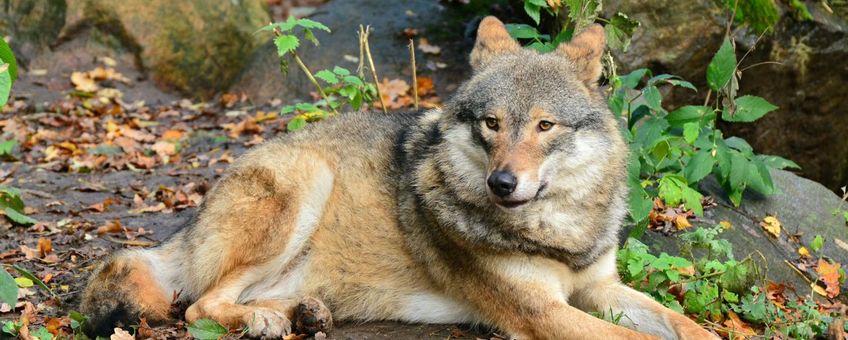
A wolf’s stowaways
Leibniz Institute for Zoo and Wildlife ResearchThis was the case, because the number of parasite species per individual wolf (Canis lupus lupus) increased as the wolf population expanded. Furthermore, cubs had a higher diversity of parasite species than older animals. The good news: wolf parasites do not pose a threat to human health.
In the course of a long-term study of wolf health in Germany, the internal organs of 53 wolf carcasses were studied in detail. They came from wolves which had died in traffic accidents or were illegally killed between 2007 and 2014.
“Whereas tapeworms are recognisable with the naked eye, the identification of single-celled Sarcocystis parasites was a real challenge, since the species of this genus do not differ morphologically”, explains Lesniak.
According to their developmental cycle, endoparasites can be grouped into two types: Some, such as many tapeworms, infect their hosts directly. Others, such as Sarcocystis parasites, first live in an intermediate host, the prey animal of the wolf, and reach their final host, the wolf, only if the intermediate host has been consumed by the final host. With the faeces of the final host, these parasites are released back into the environment. Potential prey animals of the wolf feed then on vegetation that was previously contaminated with the parasites. The parasites thereby invade the intermediate host and settle in the muscle flesh. Roe deer, red deer and wild boar are such intermediate hosts in central Europe. When these are eaten by a wolf, the parasites infect the final host, the wolf, and reproduce in its intestines.
By applying sophisticated molecular genetic analyses, the scientists identified 12 Sarcocystis species in the wolf carcasses. They also found four tapeworm species (cestodes), eight roundworm species (nematodes) as well as one fluke species (trematode). In order to examine parasite infections also in the wolf’s large prey species, the team collected internal organs of shot prey animals from hunting parties.
In Germany, wolves mainly feed on roe deer, but also red deer and wild boars. Small mammals, such as hares, voles or mice, are very seldom 'on the menu'. The identified parasites provide indirect evidence for this insight, since fox tapeworms were found in only one of the 53 wolves. Fox tapeworms are transmitted by mice and can occur in all canids, but particularly frequently in foxes. "Good news", Lesniak says, because the larvae of fox tapeworms can cause severe diseases in humans.

Wolves that died at the beginning of the study period had a lower parasite diversity than those who died later. “The bigger the population, the more often wolves are in contact with each other and their prey, and the more often they became infected with different parasites”, Lesniak summarises the results.
Currently, there are 46 wolf packs settled within Germany. A pack consists of the parents as well as the cubs of the current and the previous year and can comprise up to ten individuals. “Genetic analyses conducted by our cooperation partners for this study show that the ancestors of the Central European lowland population, which nowadays ranges from Germany to Poland, originated from Lusatia in eastern Germany”, Lesniak says. This population was probably initiated by individuals who migrated from the Baltic region at the beginning of the millennium and settled between southern Brandenburg and northern Saxony. From there, they began to spread across northeastern Germany and southwestern Poland, a process which continues to this day.
“Wolves are shy, wild animals. Thus, contact between people and wolves is rare”, Lesniak emphasises. “Nevertheless, hunters should boil the leftovers of shot game thoroughly before feeding this to their hunting dogs, in order to avoid possible parasite infections”, warns Lesniak. It is also essential to regularly deworm hunting dogs in regions occupied by wolves.
Occasionally, it has been reported that wolves come closer to residential areas; sheep farmers are complaining about losses. “It may well be that today’s wolves have learnt that it is easier to find food closer to humans – those, who once eradicated their wolf forefathers” presumes Lesniak. Of course, it is more convenient for a wolf to break into a sheep enclosure than to chase roe deer in the forest. Therefore, the implementation of appropriate protective measures of domestic animals is very important and now also financially supported by the government in Germany.
The Leibniz-IZW study, conducted in collaboration with researchers from the Humboldt University Berlin, the Leibniz-Senckenberg Research Institute and the Lupus Institute for Wolf Monitoring and Research in Germany, was mainly financed by the German Federal Environmental Foundation (DBU) and the state forest of Saxonia (Staatsbetrieb Sachsenforst).
The results of this study were published in the scientific Open Access journal Scientific Reports.
Text: Leibniz-IZW
Photos: Johan Fredriksson, CC BY-SA 3.0 (leadphoto: Eurasian wolf); Ines Lesniak, Leibniz-IZW; Mariofan13, CC BY-SA 3.0
